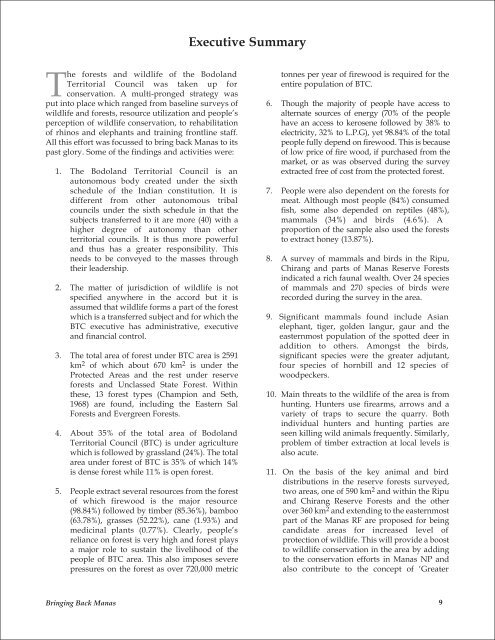Bringing Back Manas
Bringing Back Manas
Bringing Back Manas
- TAGS
- bringing
- manas
- www.ifaw.org
Create successful ePaper yourself
Turn your PDF publications into a flip-book with our unique Google optimized e-Paper software.
The forests and wildlife of the Bodoland<br />
Territorial Council was taken up for<br />
conservation. A multi-pronged strategy was<br />
put into place which ranged from baseline surveys of<br />
wildlife and forests, resource utilization and people’s<br />
perception of wildlife conservation, to rehabilitation<br />
of rhinos and elephants and training frontline staff.<br />
All this effort was focussed to bring back <strong>Manas</strong> to its<br />
past glory. Some of the findings and activities were:<br />
1. The Bodoland Territorial Council is an<br />
autonomous body created under the sixth<br />
schedule of the Indian constitution. It is<br />
different from other autonomous tribal<br />
councils under the sixth schedule in that the<br />
subjects transferred to it are more (40) with a<br />
higher degree of autonomy than other<br />
territorial councils. It is thus more powerful<br />
and thus has a greater responsibility. This<br />
needs to be conveyed to the masses through<br />
their leadership.<br />
2. The matter of jurisdiction of wildlife is not<br />
specified anywhere in the accord but it is<br />
assumed that wildlife forms a part of the forest<br />
which is a transferred subject and for which the<br />
BTC executive has administrative, executive<br />
and financial control.<br />
3. The total area of forest under BTC area is 2591<br />
2<br />
km of which about 670 km 2 is under the<br />
Protected Areas and the rest under reserve<br />
forests and Unclassed State Forest. Within<br />
these, 13 forest types (Champion and Seth,<br />
1968) are found, including the Eastern Sal<br />
Forests and Evergreen Forests.<br />
4. About 35% of the total area of Bodoland<br />
Territorial Council (BTC) is under agriculture<br />
which is followed by grassland (24%). The total<br />
area under forest of BTC is 35% of which 14%<br />
is dense forest while 11% is open forest.<br />
5. People extract several resources from the forest<br />
of which firewood is the major resource<br />
(98.84%) followed by timber (85.36%), bamboo<br />
(63.78%), grasses (52.22%), cane (1.93%) and<br />
medicinal plants (0.77%). Clearly, people’s<br />
reliance on forest is very high and forest plays<br />
a major role to sustain the livelihood of the<br />
people of BTC area. This also imposes severe<br />
pressures on the forest as over 720,000 metric<br />
<strong>Bringing</strong> <strong>Back</strong> <strong>Manas</strong><br />
Executive Summary<br />
tonnes per year of firewood is required for the<br />
entire population of BTC.<br />
6. Though the majority of people have access to<br />
alternate sources of energy (70% of the people<br />
have an access to kerosene followed by 38% to<br />
electricity, 32% to L.P.G), yet 98.84% of the total<br />
people fully depend on firewood. This is because<br />
of low price of fire wood, if purchased from the<br />
market, or as was observed during the survey<br />
extracted free of cost from the protected forest.<br />
7. People were also dependent on the forests for<br />
meat. Although most people (84%) consumed<br />
fish, some also depended on reptiles (48%),<br />
mammals (34%) and birds (4.6%). A<br />
proportion of the sample also used the forests<br />
to extract honey (13.87%).<br />
8. A survey of mammals and birds in the Ripu,<br />
Chirang and parts of <strong>Manas</strong> Reserve Forests<br />
indicated a rich faunal wealth. Over 24 species<br />
of mammals and 270 species of birds were<br />
recorded during the survey in the area.<br />
9. Significant mammals found include Asian<br />
elephant, tiger, golden langur, gaur and the<br />
easternmost population of the spotted deer in<br />
addition to others. Amongst the birds,<br />
significant species were the greater adjutant,<br />
four species of hornbill and 12 species of<br />
woodpeckers.<br />
10. Main threats to the wildlife of the area is from<br />
hunting. Hunters use firearms, arrows and a<br />
variety of traps to secure the quarry. Both<br />
individual hunters and hunting parties are<br />
seen killing wild animals frequently. Similarly,<br />
problem of timber extraction at local levels is<br />
also acute.<br />
11. On the basis of the key animal and bird<br />
distributions in the reserve forests surveyed,<br />
two areas, one of 590 km 2 and within the Ripu<br />
and Chirang Reserve Forests and the other<br />
over 360 km 2 and extending to the easternmost<br />
part of the <strong>Manas</strong> RF are proposed for being<br />
candidate areas for increased level of<br />
protection of wildlife. This will provide a boost<br />
to wildlife conservation in the area by adding<br />
to the conservation efforts in <strong>Manas</strong> NP and<br />
also contribute to the concept of ‘Greater<br />
9

















